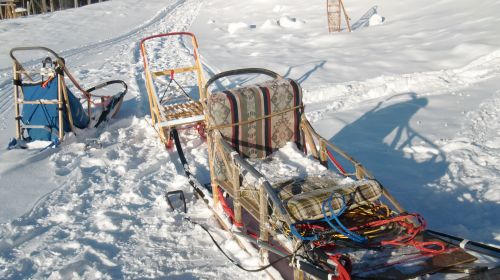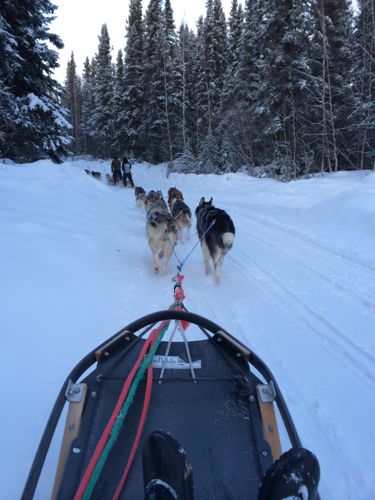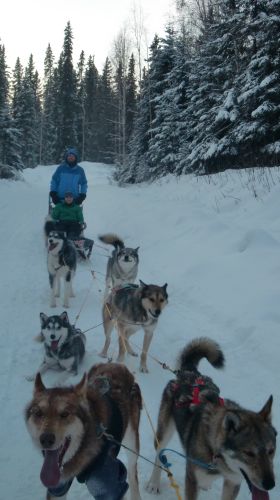Mushing School
Let's return once again to Sirius Sled Dogs for the final chapter of my story.
The Equipment
Each dog wears a harness. These harnesses are fit to the particular dog. When we were out in the yard getting oriented to the sleds and the individual dogs they were relatively quiet. A brief bark to say hello at times, but overall calm and relaxing. But as soon as their harnesses come out a chorus breaks out! They are all howling and barking, super excited at the chance to get to go for a run. You can really feel and see how much they love it!
We were handed a harness and told which dog to suit up. When you approach the dog you are supposed to have them sit on their house (if they're a smaller dog) or sit on the ground (if they're bigger). You then line up their harness, most of them are very calm for this process- much calmer than my dog when his leash comes out! They let you push the opening over their head and often will lift their paws to help you get them through the openings. Once everyone is harnessed it was time to pick the teams. Josh and Garrett selected pairs based on which position they ran best in and who got along with who. The dogs in the front position are called lead and are in charge of guiding the sled, it is important that they listen to directions and can direct the rest of the team. The next pair back are called swing or point. Often additional lead dogs are in this position to help direct the team. The next three pairs are called team and are all about power, and finally closest to the sled are wheel. They are usually the power houses and very strong.
 Checking out the sleds
Checking out the sleds
The sleds have runners that are covered in the same material as ski bases. They also have baskets for carrying people or gear. There are different sleds depending on the conditions. There are some for racing, versus recreational trails, or deep fresh snow. Finally a very important component, the brakes. There are three options for brakes. There is the drag mat for slowing speeds, the double-claw which is used both for slowing and stopping, and the claw which is like an anchor for longer stops or emergency stops. And of course there is always the option of turning the sled on its side to greatly increase friction- or if you have fallen off...
Heading Out on Trail
 The view from the sled
The view from the sled
Initially in mushing school the student is on the sled behind the teacher. They have constructed sleds that are more like two sleds hooked together which helps in the learning process. The initial feeling is crazy! Like a fun roller coaster ride on skis. You have to get the feel for turns, and balance, and how shifting your weight can cause the sled to move as well. The musher instructs the student on when and how to brake and what commands to use at different times.
 Lauren and Ethan Watel mushing their own team
Lauren and Ethan Watel mushing their own team
Shortly down the trail the student moves to the front sled, and the teacher to the back- much like in drivers ed the student is given the control (although the dogs are really more in control, let's be honest) but the teacher has their own brake for safety. They give you tips and ensure you feel comfortable because not too much further down the trail you are given your own sled! Ethan and I rode on one sled together and followed the teacher's sled.
HIKE gets the dogs started, GEE tells them to turn right, HAW is to turn left and Woah tells them it's time to stop.
We mushed for a 14 mile loop and it was amazing! One of the coolest experiences I have ever had. Watch the following video to get an idea of what a ride is like!
http://youtu.be/dCdpKwSYEU0
If you ever have the opportunity you should try mushing. See the love the dogs have for running, and that the mushers have for their dogs.


Comments